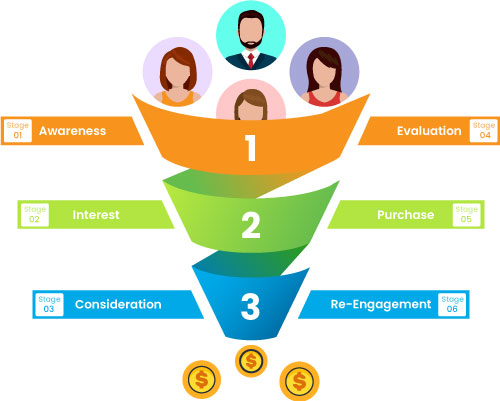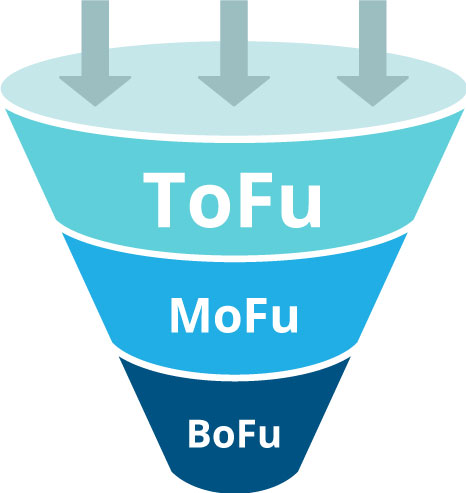Oftentimes, people consider the sales journey a consistent and orderly process but in reality, it’s complex and disheveled. Even then, the concept of a B2B marketing funnel still remains, providing valuable guidelines to sales reps to carry their work efficiently through the phases. So, this is an area where sales and marketing teams seek to improve the most.
Contents
What is a B2B marketing funnel?
A B2B marketing funnel, also known as the B2B purchase funnel, is a blueprint set down by a business to guide potential customers through their user journey i.e., from their first interaction with the firm to becoming its customer.
This blueprint comprises Search Engine Optimization (SEO), Search Engine Marketing (SEM), Social Media Marketing (SMM), paid advertising, email marketing, content marketing, and more.
Although this explanation about marketing funnels is simple enough, marketing funnels are not.
They can be quite complicated due to numerous reasons, including-
- The existence of different marketing channels.
- Customers experience a variety of pain points.
- The variation in the brand awareness level of each customer.
So, in reality, most brands have multiple funnels. For, a business might be capturing and nurturing leads through multiple channels like blog posts, social media posts, influencer endorsements, and more.
What are the phases involved in a B2B marketing funnel?
Following are the six phases/stages involved in a B2B marketing funnel.

Phase 1: Awareness
At the topmost part of the B2B marketing funnel is the awareness phase. Here, your potential customer gets to know that your product or service addresses an issue they’re currently facing. In this case, you can even get a B2B portal to keep in constant touch with your audience. It begins the moment when he/she hears or reads about your brand. It may be through a friend, a social media post, an email from your marketing team, or a search engine result page.
Stage 2: Interest
Now that your prospect has got to know the existence of your brand, he/she develops an interest in you. This depends on the value you offer or the degree of interest your content generates. Your prospects may exhibit their interest by consuming more of your content, searching your brand name on Google, clicking through your CTAs, subscribing to your emails, downloading your e-book, etc.
Stage 3: Consideration
The prospects, who are interested in your brand, next enter the consideration phase. Here, the BB buyer weighs the merits and demerits of your product/service over your competitors. In this phase, they learn about the features and benefits of your product, carry out product and price comparisons, and/or sign up for a demo or free trial.
Stage 4: Evaluation
At this phase, your prospects get serious about partnering with your company. That is, they’ve prioritized a list of vendors, and believe that you’re someone who can deliver according to their expectations. So, in this stage, they want to work out the details of the deal. So, your sales team has to work delicately with prospects to move them through it.
Stage 5: Purchase
The purchase phase is at the bottom-most part of the funnel. It’s the ultimate thing you’ve been working toward. The prospect finally decides to buy from you and become your customer. Though it takes some amount of effort and a waiting period to move your customer to this phase, it is all worth it.
Stage 6: Re-Engagement/Retention
Long-term customer relationships are quite vital in the B2B sector. If your products and services are of high quality, your customers will not only be repeatedly buying from you but also recommending you to other businesses. So, you need to keep re-engaging your customers with your brand. Besides, you should also re-engage those leads who expressed some sort of interest in your brand but didn’t convert.
How does a B2B marketing funnel work?
A B2B marketing funnel works in the following ways to increase your customer base, sales and revenue therefrom.
1. Increasing brand awareness
A B2B marketing funnel works by promoting your brand awareness. Brand awareness isn’t just about people knowing your brand name. It’s more about them understanding what makes you stand out from your competitors. You accomplish this by creating content that helps them see that you offer better value than your counterparts.
2. Reducing investment in paid advertising
Having a B2B content marketing funnel helps you lower your funds spent on paid advertisements. This is because you’re continually coming up with content that educates and engages your leads at each level of the buyer’s journey. This will lead the search engines to rank you higher. So, you’ll gain more traffic and potential customers.
3. Increasing your perceived authority in your niche
When people see that you publish content that addresses your consumer’s needs, they start considering you as an authority in your niche. You become their go-to source for information in your industry. This again increases your web traffic and improves your website ranking in the search engine result pages.
4. Increasing your sales
A study by Corporate Eye, says that 84% of buyers report buying a product or service after reading about it online. The logical flow behind is getting to know a brand, liking it, and then trusting it enough to purchase it.
5. More organic search traffic
B2B marketing funnel requires you to post content relevant for leads moving through each phase of it. This promotes your organic search traffic as your website pops up when someone is looking for products or services in your niche searches using keywords in your niche. Additionally, the traffic is also more qualified. In order to achieve this, companies usually consider SEO for B2B SaaS to get more of the right attention.
How to create a B2B marketing funnel?

The success of a B2B company largely depends on its marketing funnel. This system targets prospects with relevant offers that move them through the different marketing funnel stages and ultimately towards a sale. The multiple touchpoints in the B2B funnel help root your brand in the minds of business decision-makers. Hence, they find you the go-to brand when they’re ready to buy.
For designing a successful B2B digital marketing funnel, you need to outline the buyer’s journey, and for each phase, you need to define the goals to be accomplished, decide the offers and content to be delivered, and determine the marketing mediums to reach prospects.
We’ve given below a short guide on how to build a good B2B digital marketing funnel for your business. Use a Google spreadsheet or MS Excel to keep track of every stage.
a) TOFU (Top of the Funnel)
TOFU corresponds to the awareness phase in the buyer’s journey. It seeks to bring in fresh website traffic and leads into your sales funnel. In this phase, your potential customers become aware of the issue they’re facing and are hence searching for an ideal solution provider. So, your TOFU marketing needs to capture this audience along with those that aren’t yet ready to buy.
Here’s how you market during this phase-
- Create and publish lead magnets such as blog posts, how-to videos, infographics, online flyers, downloadable content, industry stats, checklists, cheat sheets, reports, podcasts, and more. For businesses needing scalable, engaging content, custom training videos can be an effective way to educate and captivate their audience.
- Rather than focusing on making sales informative, useful, and helpful. Use content as an opportunity to educate your audience about the solution you offer.
- Establish yourself as an authority in your niche by providing value and staying memorable.
- The best acquisition channels for TOFU are SEO, social media ads, and YouTube videos.
A B2B prospect qualifies through this phase if-
- Depicts interest in your offering.
- Needs your offering
- Has the budget to purchase your product/service
- Is in a position to make or influence the buying decision
b) MOFU (Middle of the Funnel)
The MOFU corresponds to the interest, consideration, and evaluation phases. Now, your potential customer understands the existence of the issue and begins investigating and assessing solutions.
In this MOFU stage, you need to provide context for their consideration and distinguish your brand from the rest with your unique value proposition.
Here’s what you need to do during this phase-
- Segment your leads based on the data acquired during the TOFU phase. Customer segmentation can help in effective personalization.
- Send automated personalized nurturing emails for prospects who have qualified through the TOFU stage.
- Your content should now focus on the value and benefits of your offerings.
- Prove that your solutions are useful and work effectively. Keep in mind that B2B buyers make buying decisions to improve their business and/or gain a competitive edge.
- The right content and offers at this phase are case studies, white papers, quizzes, surveys, reports, webinars, success stories, product samples, free trials, and video demos.
- The best marketing channels during this phase are SEO, email remarketing, retargeting on social media, and remarketing with Google Ads.
c) BOFU (Bottom of the Funnel)
This is the stage where your prospect makes the ultimate buying decision. This is the reason why this phase is also referred to as the Conversion stage, the Purchase stage, or the Decision stage. This conversion can take different forms such as a purchase, consultation scheduling, signing up for an account, or something else depending on your business.
Here is what you need to do during this phase
- Often the BOFU phase is handed over to the salespeople but it shouldn’t be so. The closing of the deal should take the joint effort of sales and marketing teams. For, some buyers at this stage may need more marketing push in the form of a custom-tailored deal, discount, or special offer. While others may need more education, information, trust-building, and consultation before they decide to buy.
- Your messages at this phase need to justify their choice.
- Make limited-time offers or discounts to trigger immediate action.
- Other compelling offers that work in this phase are testimonials, live demos, free trials, training, consultations, coupons, case studies, plan upgrades, estimates and quotes, success stories, etc.
- The best marketing channels during BOFU are the same as that of TOFU. That is SEO, social media ads, and YouTube videos.
It’s not the end of the marketing funnel once the B2B buyer purchase from you. You need to keep re-engaging them with your brand to retain them. Employ CRM, social media, and digital marketing to nurture them and encourage repeat business and plan upgrades. This way, you’ll increase their customer lifetime value (CLV).
Conclusion
A B2B marketing funnel is a blueprint set down by a business to guide potential customers through their user journey. It is an area where most marketers and salespeople seek to improve the most.
This blog has discussed how it works, the phases involved in it, and how to create it to help marketing and sales teams.

























 Email
Email SMS
SMS Whatsapp
Whatsapp Web Push
Web Push App Push
App Push Popups
Popups Channel A/B Testing
Channel A/B Testing  Control groups Analysis
Control groups Analysis Frequency Capping
Frequency Capping Funnel Analysis
Funnel Analysis Cohort Analysis
Cohort Analysis RFM Analysis
RFM Analysis Signup Forms
Signup Forms Surveys
Surveys NPS
NPS Landing pages personalization
Landing pages personalization  Website A/B Testing
Website A/B Testing  PWA/TWA
PWA/TWA Heatmaps
Heatmaps Session Recording
Session Recording Wix
Wix Shopify
Shopify Magento
Magento Woocommerce
Woocommerce eCommerce D2C
eCommerce D2C  Mutual Funds
Mutual Funds Insurance
Insurance Lending
Lending  Recipes
Recipes  Product Updates
Product Updates App Marketplace
App Marketplace Academy
Academy

